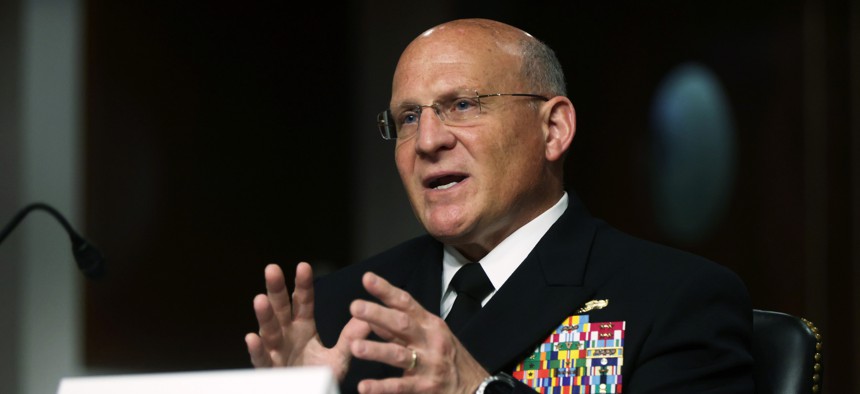
Chief of U.S. Naval Operations Admiral Michael Gilday testifies during a hearing before Senate Armed Services Committee at the U.S. Capitol June 22, 2021. Alex Wong/Getty Images
Top Navy Admiral: Fleet Size Doesn’t Always Matter
CNO Gilday says U.S. shouldn’t become like the Russians, with a big but incapable force.
The U.S. Navy may become like the Russian fleet if it focuses solely on the quantity of ships instead of on whether vessels are properly maintained, armed, and crewed by well-trained sailors, the top admiral said Monday.
The comments made by Adm. Mike Gilday, the chief of naval operations, came a week after the Navy proposed to retire two dozen warships and use the money saved to buy new ships and high-tech weapons.
“We've had to make some very difficult decisions about [the] divesting of some platforms,” Gilday said at the Navy League’s Sea-Air-Space conference in National Harbor, Maryland. “It's more than just a numbers game. It is a capabilities and a numbers game about fielding a combat credible force that can deter.”
Navy leaders have long said they need 355 ships, a number now mandated by Congress, to deter China. But that number has become fuzzier because it may count uncrewed as well as crewed ships. In recent months, Gilday has been talking about needing a fleet of 500 vessels of both types. The service has not updated its 30-year shipbuilding plan for several years, but in the meantime, the Biden administration’s 2023 budget proposal foresees the Battle Force fleet declining from the current 297 to 280.
“We need a ready, capable, lethal force more than we need a bigger force that's less ready, less lethal, and less capable,” Gilday said. “In other words, we can't have a Navy or Marine Corps larger than when we can sustain. That's important. So let's keep it real with respect to what we're going to feel out there.”
The admiral pointed to the Russian military’s struggles in Ukraine, which he ascribed partially to a lack of training and logistics.
“That's not the force that any of us want,” he said. “If we want to flip that and make capacity king, you'll end up with a force like that because you'll pay for it, with people with ammunition, with training and with maintenance.”
Gilday several times during his remarks mentioned that the Pentagon was “maxing out production” of stealthy, long-range cruise missiles that can strike ships and ground targets.
“The investments that we're making in hypersonics, to deliver that capability by mid-decade, as well as the critical [research and development] in microwave and laser technology that gives us an enhanced capability to defend that fleet become incredibly important,” he said.
The Biden administration has asked Congress to approve $180.5 billion for the Navy in 2023, nearly 5 percent more than the amount enacted by Congress for the current fiscal year.
That proposal calls for retiring 24 ships, 16 earlier than planned. That list includes nine Freedom-class littoral combat ships, five Ticonderoga-class cruisers, two Los Angeles-class submarines, four landing dock ships, two oilers, and two expeditionary transfer docks. At the same time, the 2023 budget proposal calls for ordering nine ships, 2.5 Virginia-class attack submarines plus advanced procurement funding for more; two destroyers; that Constellation-class frigate; an LPD-17 amphibious transport dock; and a one salvage ship. The Navy is also seeking to buy two secondhand sealift ships.
Over the next five years, the Navy documents say, the Biden administration plans for shipbuilding spending to remain in the mid-$20 billions, totalling about $150 billion by 2027. By then, the size of the Battle Force fleet will have drifted downward from the current 297 to 280.
NEXT STORY: In About-Face, Army Expects to Shrink Next Year




